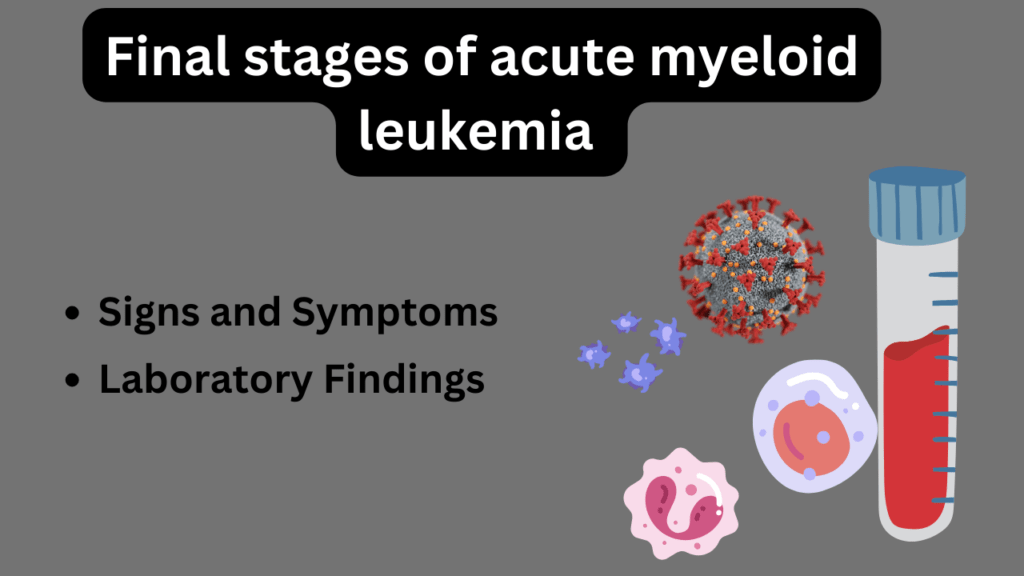The final stages of acute myeloid leukemia (AML) are characterized by a worsening of the disease, severe symptoms, and complications.

These symptoms can vary among individuals, but the following are common signs and symptoms that may be observed in the advanced or end-stage of AML:
- Severe Fatigue: As AML progresses, fatigue becomes increasingly pronounced and debilitating. Patients may feel extremely weak and exhausted, even with minimal physical activity.
- Pallor: Severe anemia, which is common in advanced AML, can lead to extreme pallor (pale skin and mucous membranes). This is due to a significantly reduced red blood cell count and reduced oxygen-carrying capacity of the blood.
- Bruising and Bleeding: Thrombocytopenia, or a low platelet count, can result in spontaneous bruising and bleeding. Patients may notice frequent nosebleeds, gum bleeding, easy bruising, and prolonged bleeding from minor cuts or injuries.
- Infections: Neutropenia, or a low white blood cell count, leaves the patient highly susceptible to infections. Infections may become frequent and severe, often requiring hospitalization and intensive antibiotic treatment.
- Bone Pain: Patients may experience severe bone pain, particularly in the long bones (arms and legs). This pain can be due to the infiltration of leukemia cells into the bone marrow.
- Enlarged Spleen or Liver: AML can lead to the enlargement of the spleen (splenomegaly) and/or the liver (hepatomegaly). These enlarged organs may cause discomfort or pain in the abdomen.
- Shortness of Breath: In advanced AML, the leukemia cells may infiltrate the lungs, leading to symptoms like shortness of breath and difficulty breathing.
- Neurological Symptoms: In some cases, leukemia cells may infiltrate the central nervous system (CNS). This can result in neurological symptoms, such as headaches, confusion, or changes in consciousness.
- Weight Loss: Unintentional weight loss is common in the final stages of AML due to a combination of factors, including loss of appetite, metabolic changes, and the overall toll of the disease on the body.
- Severe Complications: Patients in the final stages of AML are at risk of severe complications, including sepsis (a life-threatening infection that can rapidly worsen), organ failure, and bleeding disorders.
- Limited Response to Treatment: Unfortunately, advanced AML often becomes resistant to standard treatments, such as chemotherapy. This can make it challenging to achieve remission or control the disease effectively.
Final stages of acute myeloid leukemia Laboratory findings
In the final stages of acute myeloid leukemia (AML), laboratory findings may reveal significant abnormalities reflecting the advanced and aggressive nature of the disease.
Here are the laboratory results and abnormalities associated with the final stages of acute myeloid leukemia :
Complete Blood Count (CBC)
- Low Hemoglobin (Anemia): Hemoglobin levels may be severely low, leading to profound fatigue, pallor, and weakness.
- Low Platelet Count (Thrombocytopenia): Thrombocytopenia can result in a high risk of bleeding, leading to petechiae (small red or purple spots on the skin), easy bruising, and prolonged bleeding from minor injuries.
- Low White Blood Cell Count (Neutropenia): Neutropenia increases the risk of severe infections, as the body has a limited ability to fight off pathogens.
- Peripheral Blood Smear: Examination of a peripheral blood smear may reveal a high number of blast cells, which are immature white blood cells, indicating uncontrolled leukemia cell proliferation.
- Bone Marrow Aspiration and Biopsy:
- Hypercellular Marrow: The bone marrow may be hypercellular, primarily composed of leukemia cells, with reduced normal hematopoietic (blood-forming) cells.
- Replacement of Normal Cells: Leukemia cells replace healthy blood-forming cells in the marrow, leading to severe cytopenias (low blood cell counts).
- Blast Cells: AML is characterized by a high percentage of blast cells (typically >20%) in the bone marrow.
- Coagulation Profile: Abnormalities in coagulation tests may be observed, indicating a bleeding diathesis. These abnormalities can include prolonged prothrombin time (PT) and activated partial thromboplastin time (aPTT).
- Electrolyte Imbalances: In advanced AML, electrolyte imbalances can occur due to complications such as tumor lysis syndrome or kidney dysfunction. These imbalances may affect levels of potassium, calcium, and phosphate in the blood.
- Liver and Kidney Function Tests: As AML progresses, it can affect organ function. Liver function tests (e.g., liver enzymes) and kidney function tests (e.g., serum creatinine) will be abnormal.
- Lactic Acidosis: Elevated levels of lactic acid in the blood (lactic acidosis) can occur in advanced AML and may contribute to metabolic and respiratory problems.
- Serum LDH: Elevated lactate dehydrogenase (LDH) levels may be present, which can be indicative of tissue damage and increased cell turnover.
- Blood Gas Analysis: Arterial blood gas (ABG) analysis may reveal respiratory alkalosis or acidosis, depending on the patient’s specific condition and complications.